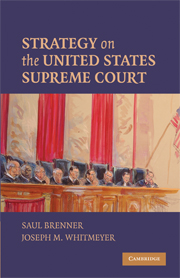Book contents
- Frontmatter
- Contents
- Preface
- PART I INTRODUCTION
- PART II CERTIORARI
- PART III THE CONFERENCE VOTE ON THE MERITS
- PART IV THE MAJORITY OPINION AND OTHER OPINIONS
- 8 The Extent of Successful Bargaining over the Content of the Majority Opinion
- 9 The Size of Opinion Coalitions
- 10 At Whose Ideal Point Will the Majority Opinion Be Written?
- 11 Reciprocity on the Supreme Court
- PART V THE FINAL VOTE ON THE MERITS
- PART VI CONCLUDING CHAPTERS
- Appendix 1 Decision Making on the United States Supreme Court
- Appendix 2 Additional Questions to Explore
- References
- Table of Cases
- Index
10 - At Whose Ideal Point Will the Majority Opinion Be Written?
Published online by Cambridge University Press: 05 June 2012
- Frontmatter
- Contents
- Preface
- PART I INTRODUCTION
- PART II CERTIORARI
- PART III THE CONFERENCE VOTE ON THE MERITS
- PART IV THE MAJORITY OPINION AND OTHER OPINIONS
- 8 The Extent of Successful Bargaining over the Content of the Majority Opinion
- 9 The Size of Opinion Coalitions
- 10 At Whose Ideal Point Will the Majority Opinion Be Written?
- 11 Reciprocity on the Supreme Court
- PART V THE FINAL VOTE ON THE MERITS
- PART VI CONCLUDING CHAPTERS
- Appendix 1 Decision Making on the United States Supreme Court
- Appendix 2 Additional Questions to Explore
- References
- Table of Cases
- Index
Summary
Although United States Supreme Court scholars have long recognized that the majority opinion constitutes “the core of the policy-making power of the Supreme Court” (Rohde and Spaeth, 1976, p. 172), only recently have a number of scholars systematically investigated the processes involved in the drafting of this opinion (e.g., Epstein and Knight, 1998; Maltzman, Spriggs, and Wahlbeck, 2000; Bonneau, Hammond, Maltzman, and Wahlbeck, 2007). But none of the recent research supplies us with a good answer to the question: At whose ideal point will the majority opinion be written? In their conclusion to their famous text, Segal and Spaeth (2002, pp. 434–435) list this question as one of the six questions that ought to be explored. And Westerland (2003, p. 2) maintains that this question is “arguably the most important outstanding question about what the Court does.”
Why should Supreme Court scholars be interested in at whose ideal point the majority opinion will be written? The main reason is that answering this question will increase our understanding of (1) the content of the majority opinion, (2) coalition formation on the Court, (3) the goals of the majority opinion assigner and writer, and (4) the consequences of majority opinion assignment. Concerning the latter, if the majority opinion writer tends to write the opinion at her own ideal point or at a point close to it, which justice is assigned to write the opinion in a given case is of great importance, but which justice is assigned to author the majority opinion is not of great importance if the majority opinion writer tends to write the majority opinion either at the ideal point of the Court median or at the ideal point of the conference coalition median.
- Type
- Chapter
- Information
- Strategy on the United States Supreme Court , pp. 87 - 102Publisher: Cambridge University PressPrint publication year: 2009



